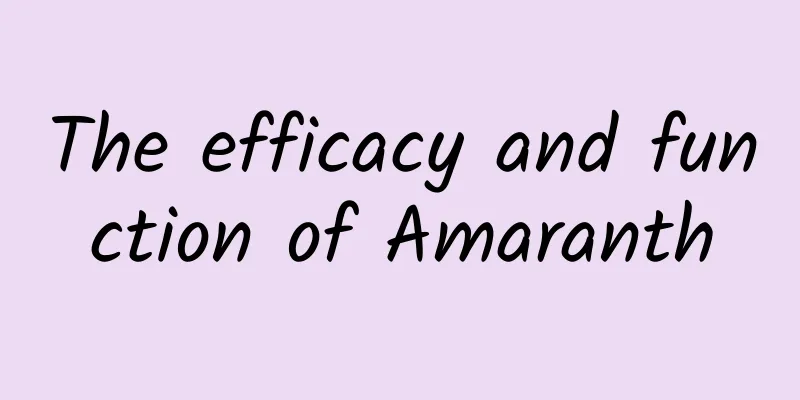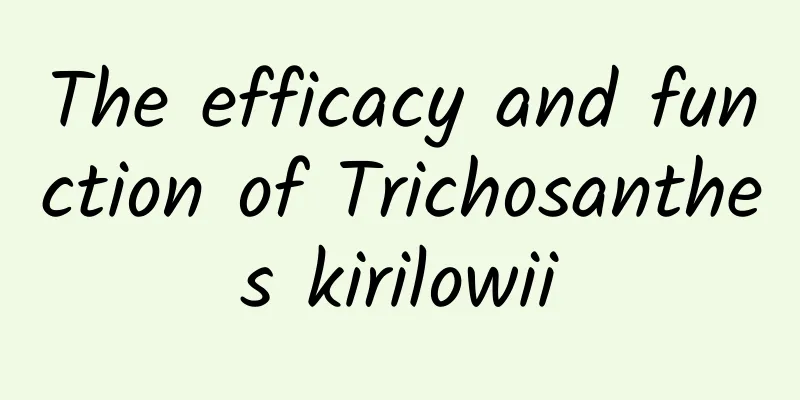The efficacy and function of Amaranth

|
Amaranth is a traditional Chinese medicinal material. There are precedents of using Amaranth to treat diseases in ancient times, so we can eat it with confidence. Next, I will mainly introduce to you the effects of Amaranthus. [Other names] Amaranth, wild amaranth, earth amaranth, pig sow vegetable, wild amaranth, thorn grass, wild amaranth, sour amaranth, amaranth [Source] Medicinal material source: the whole herb or root of Amaranthus spinulosa of the Amaranthaceae family. [Original morphology] Perennial erect herb, 0.3-1m high. Many branches, with longitudinal stripes, the stem is sometimes red, smooth below and slightly hairy above. Leaves are alternate; petiole is 1-8cm long, glabrous, with 2 spines beside it; leaf blade is ovate-lanceolate or rhomboid-ovate, 4-10cm long, 1-3cm wide, with obtuse tip, cuneate base, entire or wavy margin, midrib raised on the back, with fine spines at the tip. The panicles are axillary and terminal, 3-25cm long; the flowers are unisexual, with female flowers clustered in leaf axils and spherical; the male flowers are clustered in terminal erect or slightly drooping cylindrical spikes; the flowers are small, with spiny bracts that are about the same length as or longer than the sepals, and the bracts often transform into 2 sharp thorns, a few with 1 thorn or no thorns; the tepals are green, with acute tips and transparent margins; there are 5 sepals; 5 stamens; 3 stigmas, sometimes 2. The utricle is oblong, irregularly split below the middle, and enclosed in persistent perianth segments. The seeds are nearly spherical, black with brownish black. The flowering period is from May to September, and the fruiting period is from August to November. [Habitat distribution] Ecological environment: Wild in wasteland or gardens. 【Properties】 Identification: The taproot is oblong-conical, some with branches, and slightly woody. The stem is cylindrical, much branched, brown-red or brown-green. The leaves are alternate, wrinkled, ovate or diamond-shaped when flattened, 4-10cm long, 1-3cm wide, with fine thorns at the tip, entire or wavy margins; the petiole is the same length as the leaf blade or slightly shorter, with a pair of strong thorns in the axil. The male flowers are gathered in terminal panicles, and the female flowers are clustered in the leaf axils. The capsule is nearly ovoid and the lid is cracked. Slight odor, light taste. [Chemical composition] The whole plant contains n-alkanes C23-C33 and isoalkanes C29-C33, esters C18-C32, free alcohols C20-C26, fatty alcohols C10-C32, sterols include β-sitos-terol, stigminasterol, campesterol and cholesterol, free acids C4-C33, C18 group includes stearic acid, oleic acid and linoleic acid. It also contains flavonoids, mainly rutin. Hentriacontane and α-spinasterol, proteins and amino acids are obtained from the stems and leaves. The amino acids mainly include lysine, methionine, cystine, tryptophan, alanine, serine, valine and leucine. : : : : : : : : : : : : : : : 【Nature and flavor】 Sweet; slightly cold 【Functions and indications】 Cooling blood and stopping bleeding; clearing away dampness and heat; detoxifying and eliminating carbuncle. It is mainly used for gastric bleeding, blood in stool, hemorrhoidal bleeding, cholecystitis, cholelithiasis, dysentery, diarrhea caused by damp heat, leucorrhea, painful urination, sore throat, eczema, carbuncle, gingival erosion, and snake bites. [Usage and Dosage] For oral use: decocted in water, 9-15g, fresh product 30-60g. For external use: take appropriate amount and mash it for application; or decoct it into a water solution for fumigation and washing. 【Note】 Guangxi Chinese Materia Medica: "It is contraindicated for people with chronic diarrhea and pregnant women." Fujian Materia Medica: "According to folk experience, this product is slightly toxic. Excessive dosage may cause side effects such as dizziness, nausea, and vomiting. It is contraindicated during menstruation and pregnancy." [Additional recipe] "Lā" is a dialect. In Guangdong and Guangxi, the thorns on bamboo are called "Lā". The bracts of this product are often deformed into sharp thorns, like bamboo thorns, so it is also known as Amaranth and Thorny Amaranth. 【Excerpt】 Chinese Materia Medica Above we introduced what Amaranthus aviculare is. We know that Amaranthus aviculare is a common Chinese herbal medicine with good health-preserving and healthcare effects. It has many benefits to the human body and can relieve many symptoms. How about it, do you understand? |
<<: The efficacy and function of Li
>>: The efficacy and function of tiger bone glue
Recommend
What is the effect of snake venom mask?
Nowadays, there are more and more folk remedies f...
Who is suitable for taking a nap? Why do some people feel dizzy when they wake up, while others feel relaxed?
"I can't remember how long it has been s...
The efficacy and function of Shengmai Drink
Some people may be relatively unfamiliar with She...
What is the method and dosage of Tianma?
I believe that most people don’t know much about ...
Global Science News | Nuclear power heating! Shandong Haiyang becomes the first "zero-carbon" heating city in China
Nuclear energy Shandong Haiyang starts nuclear en...
When drawing blood on an empty stomach, what does “empty stomach” mean?
Fasting blood drawing is a common clinical examin...
Can I continue to take oseltamivir to prevent influenza during the flu season? It is not recommended to do so. A better way to prevent influenza is to →
gossip "You can continue to take oseltamivir...
When people eat grains, they always have to deal with “emissions”… How to “puff puff puff” elegantly?
When people eat grains, they always have to deal ...
Technology Morning News | Research shows drinking more coffee can prevent Alzheimer's disease
【Today’s cover】 Qilin Gorge is located in Qiongzi...
How to take bear bile powder
How to eat bear bile powder? I believe many peopl...
Urgent reminder! There is a risk of electric shock when opening a delivery locker during a thunderstorm!
The Chongqing Meteorological Bureau predicts that...
Prevent the spread of unexplained acute severe hepatitis in children! The General Administration of Customs has made arrangements
In response to reports of unexplained cases of ac...
Can't tell the difference between elk, moose and reindeer? What kind of deer does the English word "elk" refer to?
In this age of Internet development, when we come...
Effects and functions of Celastrus orbiculatus
Celastrus orbiculatus has a long history, and up ...









